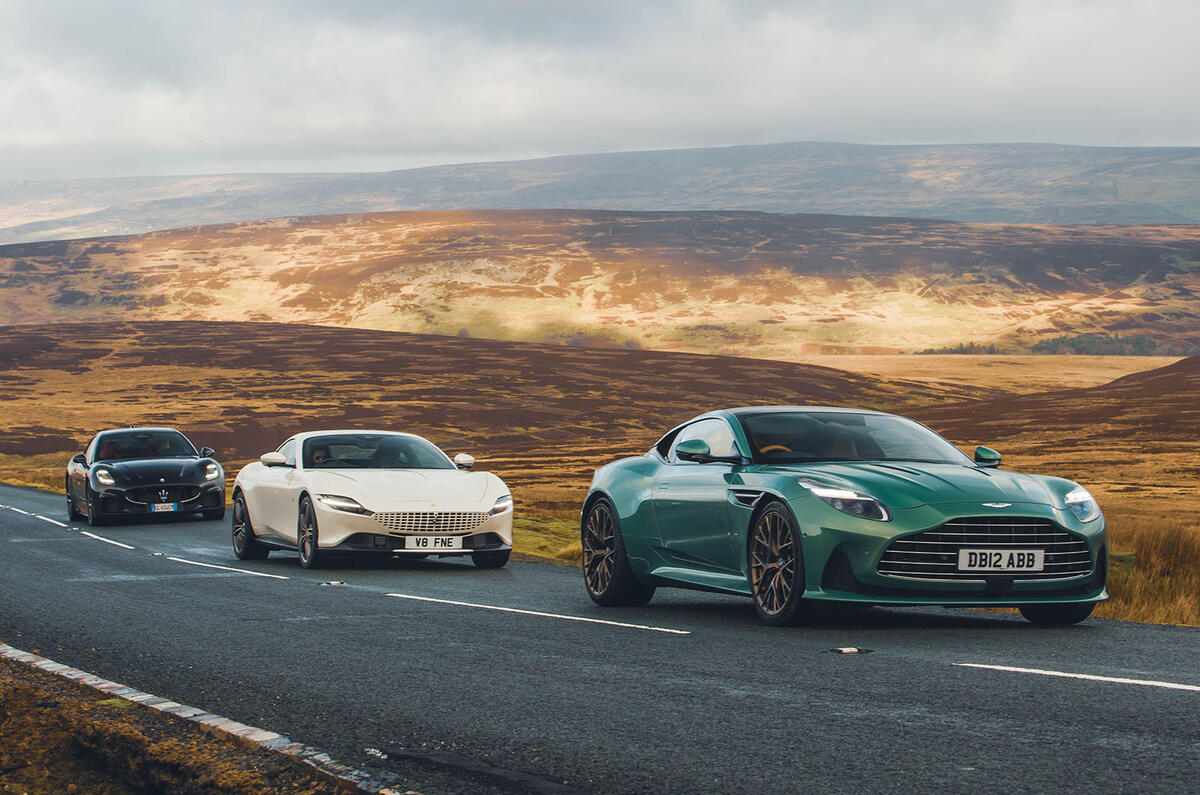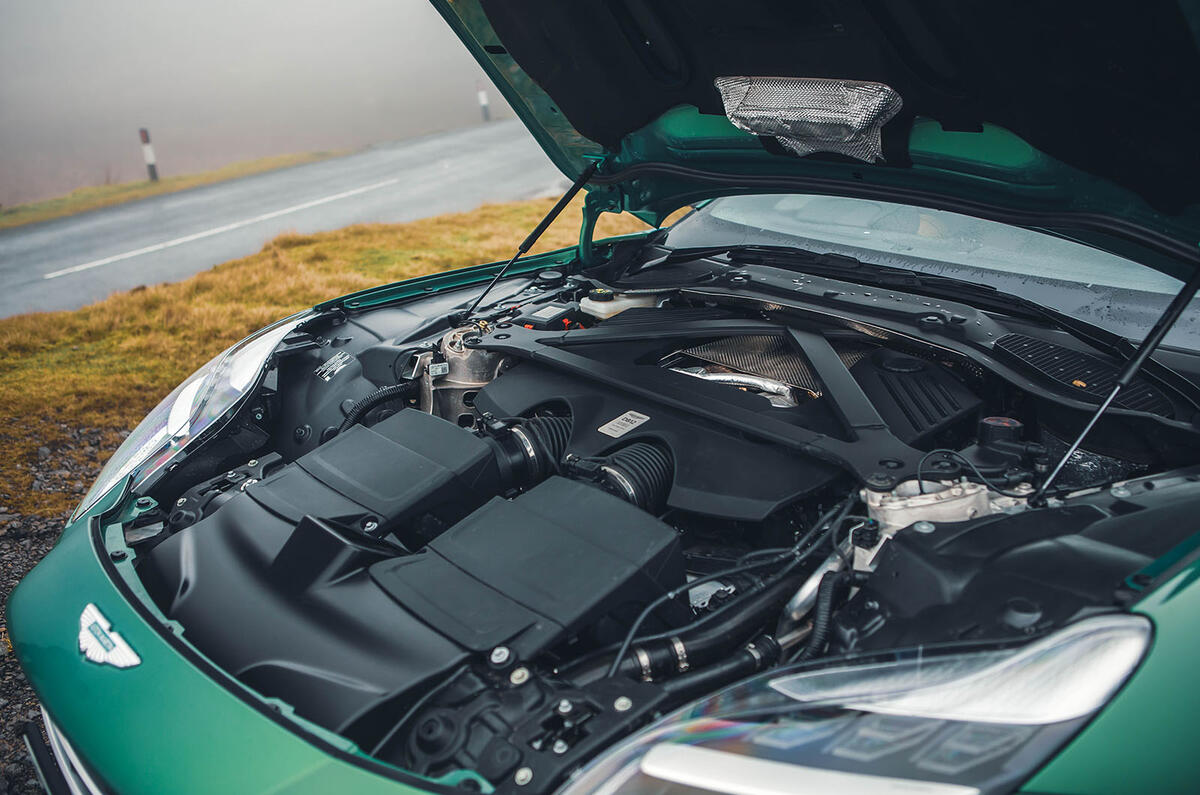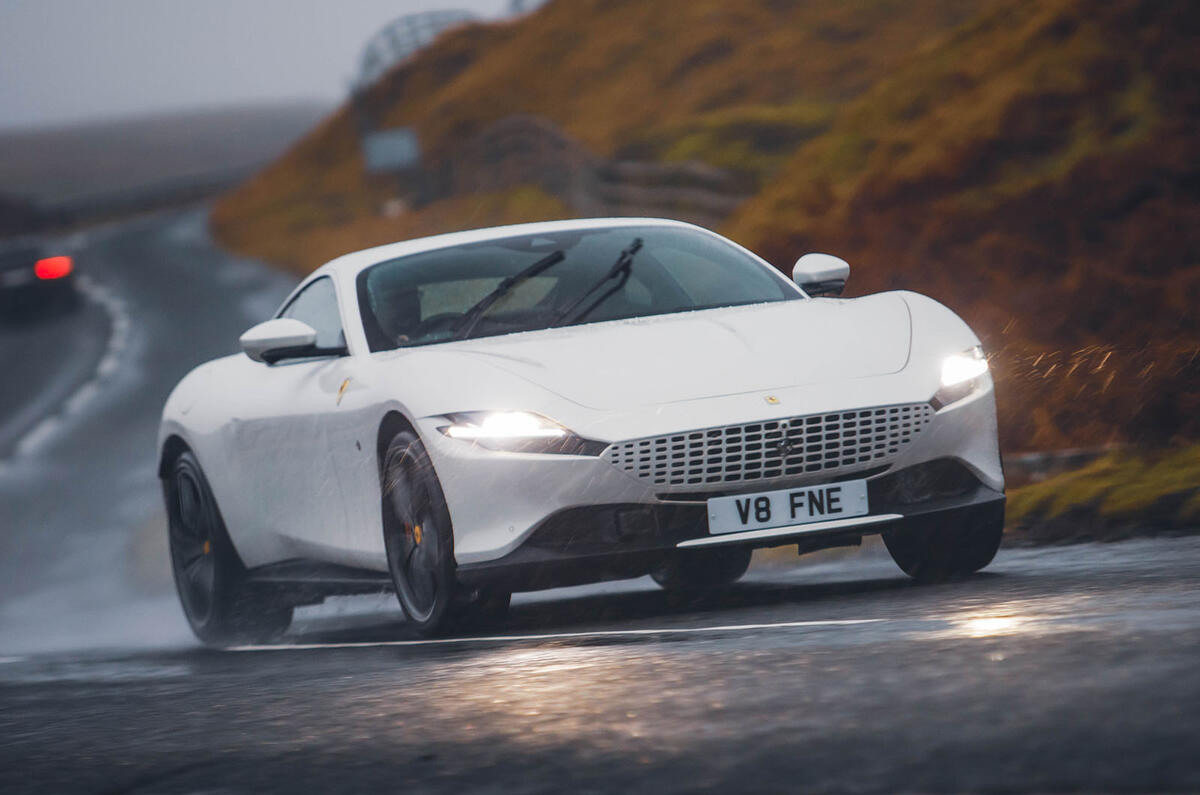There’s some debate about exactly who invented the grand touring coupé but very little about where, in national terms, it happened.
The popular response to the question of what the first and defining example was is the 1951 Lancia Aurelia B20 GT (extra credit if you reel off the whole lot in a mockney twang, like Paul Whitehouse in his grocer’s apron).
It could have been the 1948 Ferrari 166 Inter, though, or the 1947 Maserati A6 – or something pre-war, even. Wherever the credit eventually comes to rest, however, the gran turismo was definitely given life and then popularised in Italy.
And rather regrettably, it might have just been slaughtered in Warwickshire. That’s because, as far as Aston Martin is concerned, the grand tourer concept, although fine for the likes of its own DB5, Mercedes-Benz’s 300 SL, Jaguar’s E-Type and Ferrari’s Daytona, just isn’t ‘grand’ enough to effectively describe its new DB12.
We’re to call this a super tourer, apparently.

Introducing the Aston Martin DB12, Maserati Granturismo, and Ferrari Roma
Quick links: Introduction - Exterior design - Powertrains - Interiors - Driving dynamics - Verdict - Full specs
Luckily, we can now leave Aston’s marketing spiel far behind, because this widely updated coupé is about to test its worth by becoming the British beef in an Italian panino sandwich.
On one flank is the brand-new Maserati Granturismo Trofeo, on test here in left-hand-drive form but due to arrive in the UK very soon in right-hand drive.
On the other is the car that its DB11 predecessor could never quite topple: the painfully pretty, wonderfully agile and demonstrative Ferrari Roma.
Whatever you want from a GT, be it beauty, elegance, pedigree, pace, luxury, touring practicality, excitement, noise or just the most worshipful status in the golf club car park, you will find it here.
Our chilly, foggy, sodden test day in the North Pennines is hardly Lago di Como in the spring, but it has nonetheless taken us a long time to get here.

We have come in the modern heirs of a line of luxury cars that so famously have had and done it all. Big engines, big performance, aerodynamic bodies and formidable long-distance touring capabilities.
A comfortable, sophisticated, assured yet supple ride and fine high-speed stability to match the thoroughbred handling poise. Inviting, lavish and practical cabins made to feel like exclusive, enveloping bubbles of luxury. And all of that delivered within bodies of peerless elegance and world-class style.
When picking the line-up for this test, I couldn’t think of better current yardsticks for the new Aston’s kerbside appeal than these two Italian coupés. And now that they’re parked next to each other in a misty County Durham roadside nook?
Exterior design
I’d say the Roma’s status – its unmistakably classic proportions and that instant, effortless sense of style – remains as assured as ever. It looks every inch the modern inheritor of the legacy of the 1964 275 GTB (even though, technically, it isn’t).

The DB12 is bigger and wider and more chiselled in its muscular features but no less evocatively proportioned - handsome, perhaps, rather than pretty. For the Granturismo, however, we seem to be in tougher territory.
Its proportions aren’t quite perfect. Oddly long-looking in its wraparound ‘cofango’ bonnet, it seems that little bit drawn and stretched.
Lower-waisted and less aggressive than the DB12, definitely, but also saddled with just a hint of visual awkwardness.
The Maserati is a bigger car than either the Aston or the Ferrari, and that gives it some relative strengths (to which we will come), but, albeit narrowly, it misses their standard for outright design allure.
Powertrains
What the Maserati counters with might be very useful in these wintry test conditions: part-time four-wheel drive.

The junior member of this GT trio in terms of both power and price, it offers six turbocharged cylinders instead of eight. But on these roads, especially when there are plenty of bumps, cambers and puddles with which to contend, how you use what you’ve got could well prove to be more important than the number of horses you brought along in the first place.
The DB12 certainly brought plenty. Aston’s new Mercedes-AMG-supplied twin-turbocharged 4.0-litre V8 is of a different order of potency than the one that served hitherto in the DB11 (and indeed in the Vantage) and apparently gives the car a class-leading power-to-weight ratio – a claim that, compared with the Roma at least, my back-of-the-envelope maths indeed confirms.
Aston’s structural overhaul of its DB chassis, plus the upgrade under the bonnet, has taken some weight out of the new coupé compared with its predecessor, too. It’s interesting, though, that the still-lighter Roma retains the faster acceleration claim – from 0-62mph, at least.
Interiors
Before we get going, we will take in three quite different driving environments – and we will find both departures and differentiators in doing so.
Neatly enough, these three cars bridge the full breadth of the modern GT class on cabin practicality, the Roma being about as little as any exotic 2+2 coupé you will find and the Granturismo about as large.
With kids of primary school age who seldom turn down the offer of a ride in a nice car, I have at least vicariously tested the second-row seats in all three of these cars.

In the Granturismo, they are almost as comfortable as they might be in a smallish saloon, and no sacrifice on front-row space is necessary to make them so.
In the DB12, they can be made comparable, but only if mum and dad squeeze their seats forward a little. In the Roma, four-up motoring always feels tight, even when two of you are younger than 11.
For boot space, it’s a similar story: the DB12 and Roma are some way behind the Granturismo.
Clearly, however, a lavish and comfortable environment for two occupants is of far greater importance for these cars than how well they might pass tougher practicality tests, and here the Granturismo’s positioning isn’t so strong.
While its interior goes bigger than its rivals on touchscreens, its wider secondary controls look and feel cheaper and more plasticky.

Its row of PRND transmission control buttons across the top of the centre stack somehow looks a bit unbecoming in a £160,000 car (perhaps ironically, this was how Aston used to do it) and its plasticky push-button door release switches might cut it in a Fiat 500 but are less convincing here.
So while the Roma and DB12 offer lower, more couched driving positions than the Granturismo and the latter comparable front-row space for heads, knees and elbows, the Brit actually moves away from the Italians for interior quality and luxury cabin appeal.

Yes, you read that bit right. If the DB12 draws a line in the sand for Aston, it isn’t with its new, in-house-designed, 10.3in touchscreen multimedia system or its 671bhp V8 engine; it’s with so many knurled-metal knobs and switches and plenty of other expensive bits of cabin trim besides that give the car a real aura of material lavishness.
It’s not a perfect interior. Our test car had a little bit of Aston-typical wonky interior panel fit around the driver’s door and a couple of very slightly wobbly armrest consoles. Even so, I would say no modern DB before has conjured such a broadly convincing, expensive luxury cabin ambience.
It’s enough to make the DB12 feel like a more special place to be than either the tighter and plainer Roma or the marginally comfier but materially less exotic Granturismo.
Driving dynamics
We have three modern GT coupés here and not an electric drive motor in sight. Yum. Might it be the reverence manufacturers pay to this particular segment that explains why some have been slow to electrify it?
Well, Maserati is about to have a go (the delayed Granturismo Folgore is due on UK roads later this year with 750bhp), but for now we can instead savour three tributes to internal combustion – and three cars that all have a tank big enough to put a good 400 miles between refuelling stops.
These are all effortlessly fast cars, just as they should be. That the Granturismo feels that little bit gentler in full flight than either the DB12 or the Roma is mostly academic on moorland roads that are fairly narrow and treacherous in places, that don’t tend to go straight for more than 200 yards anywhere but are bumpy enough always to sort a really well-suspended car from an only average one.

Maserati’s big-boosted Nettuno V6 keeps the Granturismo responsive on them, and its rorty, bassy exhaust gives it plenty of sporting presence. It goes well. It doesn’t project like the DB12, though; and it revs like neither that car nor the even more rapacious Roma.
There’s a malleability to the Granturismo’s power delivery that suits these slippery roads, though, and, by stark contrast, an unforgiving sharpness to the Ferrari’s V8 that makes it much more of a feisty handful – for both good and bad.
I know from experience that, on better surfaces and in warmer temperatures, the Roma’s up-on-its-toes handling really is a marvel. It’s agile, playful, light-feeling and always ready to entertain, like few GTs have ever been. But here and now, it’s a car that you take past 4000rpm very advisedly indeed.

Ferrari’s PR man did offer to fit winter tyres to it, but since neither of his opposite numbers from Maserati or Aston Martin did, I told him to leave the standard rubber in place. But as the highly strung Roma sends flurries of wheelspin through its rear axle and threatens to hop sideways over bumps, I’m having second thoughts.
Wet driving mode calms down the diff somewhat and keeps your heart out of your mouth – just. But even so, I’m not sure this is strictly the right kind of fun for a fast, versatile modern GT to be aiming for.
Still, what an engine Maranello has made here. It’s supremely linear with its mid-range torque and then keeps on spinning up beyond 7000rpm when called to.
On the ear, it’s waspish and a little hard-edged – not like the more mellifluous, bellowing AMG M177, which sounds much more like you think a V8 should. But crikey, it’s potent. Whatever the numbers may say, the Roma feels like the quickest car here by a clear margin.

Yet on a typical touring trip, I don’t know how much occasion I would have to uncork that engine or to feel like I was really tapping into what the Roma does best.
What the Granturismo seems to do best is very different: faster, more effortless, luxury-class cruising on smoother roads than this.
Over bumps, its adaptively damped air suspension struggles somewhat to maintain good close body control and to keep those 20in and 21in rims on the ground.
Its lighter, more rubbery-feeling steering doesn’t make it as easy to keep perfectly on line as it might. But the contrast between both Italians and the DB12 really is impressively plain.

This is clearly a firmer-suspended Aston GT than we are used to, which has a slightly more fiddly low-speed ride, but it steers really well, with tactile weight well matched to its gearing, a fine sense of intuitive precision and perfect fine directional response.
Then as you gather speed, the sophistication of the DB12’s new damping system starts filtering smaller lumps and bumps, without letting the bigger ones cause its mass to gently jounce and heave like the DB11 might have.
It’s a big car, the DB12, and feels it – but it deals with tough roads and wet conditions much better than you would dare believe.
Verdict
On another day, in another place, its size and weight might have counted against it that bit more, while the Roma’s sharpness, lightness, finer balance and more rapacious appetite for speed might have made it harder to see past. But not here, not today.
The sheer handling composure of the DB12 makes it made for grand touring in not-so-grand weather.
Thanks to greater attention to detail around the interior, it has both of its Italian opponents beaten for lavish cabin appeal, and it’s missing nothing for digital cabin technology, either.

And thanks to the upgraded engine and driveline, it really can live with the quickest GTs in its class in terms of performance, handling and dynamic composure.
Some will say the Aston is just a facelifted DB11, others that its new cabin technology is no great leap on what went before, after all – not yet, at any rate. And they may have points.
But they would be missing the obvious one: that, clearly with the benefit of some new-era corporate detachment, Aston has managed to take a step back, has addressed the key failings of its core car and has polished its key dynamic strengths to a class-leading standard.
I wouldn’t call it ‘super’, but thankfully the DB12 now speaks loud and clear entirely for itself.
1st. Aston Martin DB12
A much more complete modern GT than the DB11 it has replaced, with greater luxury cabin allure and the pace, composure and driver appeal to top its class.
2nd. Ferrari Roma
Singularly agile, compact, vivid and exciting among front-engined GTs but perhaps a little bit too highly strung to deal well with wintry conditions.
3rd. Maserati Granturismo Trofeo
Has lots of space and plenty of outright pace and luxury touring potential, but it would make best sense at a lower, less exotic price than this.
Full specs




























Join the debate
Add your comment
Every one is a masterpiece, you'd be thrilled to drive one, but twist my arm and - DAMN - the DB12 is just the perfect brute-in-a-suit Brit GT. Great England FTW!!!
Matt Sunders starts his article by posing the question ‘Who invented the Grand Tourer’ and goes on to say the popular answer is the 1951 Lancia Aurelia B20 GT. Somewhat strange I thought, given that both the 1948 Ferrari 166 Inter and 1947 Maserati A6 predate it.What’s more, especially as the article concerns Ferrari, Maserati and Aston Martin, why not mention the Aston DB2? Introduced in 1950 with WO Bentley’s sublime 2.6 litre twin cam, straight six it’s surely worth more of a shout as an early example of a GT than the Lancia. A case of the forgotten Astons from Feltham? Matt must know there was a life for Aston Martin before the DB5!